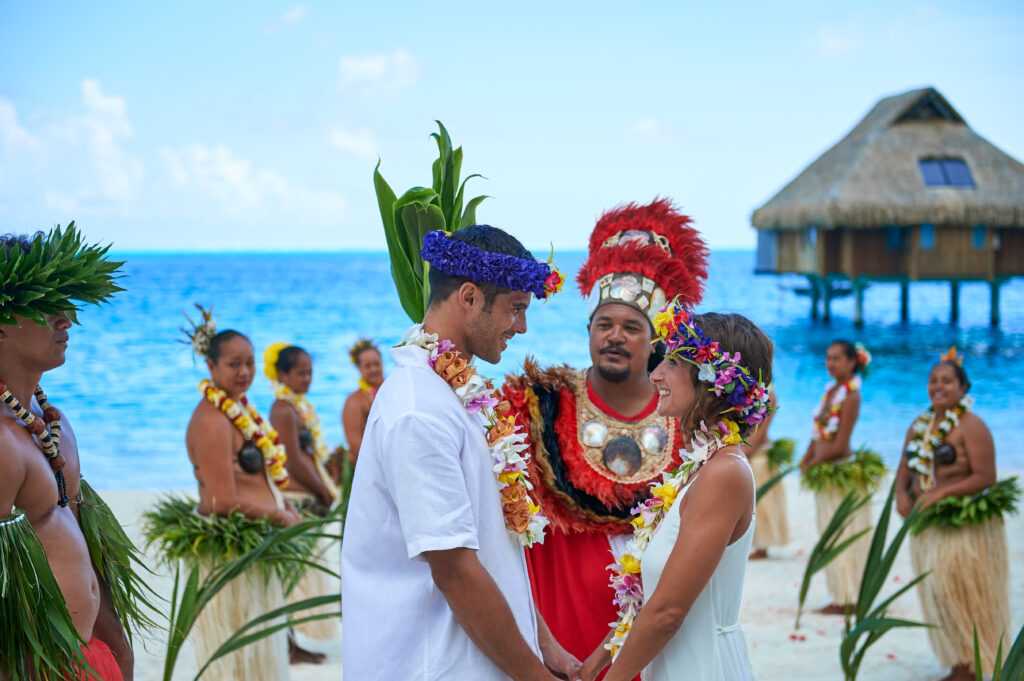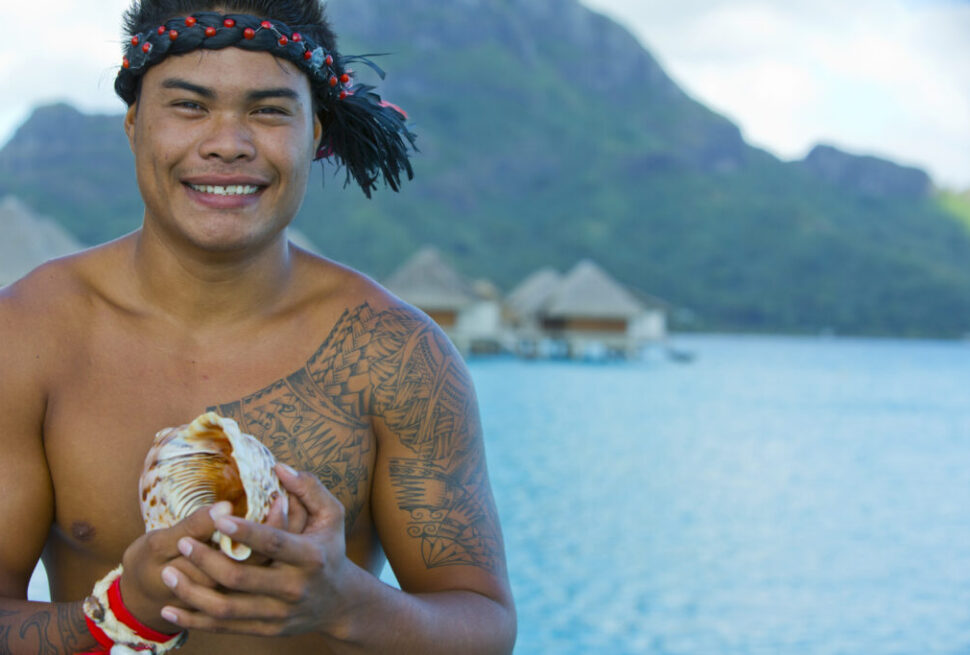In traditional society
Whatever may have been said by the European “discoverers” of French Polynesia at the end of the eighteenth century, behaviour in traditional pre-European society was far from being as dissolute as is suggested by the legend of this “paradise”. These discoverers’ accounts very often imply that marriage among the mā’ohi was nothing more than a formal agreement with very little in the way of feelings or love, with no social or religious consequences, and in which the sexual act was the principal objective. But that was far from the case.
A major role
In a Polynesian society, which was far more complex than one would have thought from the earliest accounts of observers, Polynesian marriage followed precise rules and rituals. It marked, in fact, the reaching of the age of responsibility. As soon as two young people had decided to get together, they first had to obtain the consent of their respective parents. The greater the assets or power at stake, the more cautious and complicated were the negotiations. There was no question of marrying outside of one’s caste (or social class), on pain of being stripped of one’s rank and privileges. Although the rituals may have been slightly different, and the costs involved may have varied considerably, according to the caste of the bride and groom, the religious basis and the importance of the commitment were the same for everybody.
Crucial issues sometimes at stake
In Polynesia as elsewhere, the more there was at stake, the more common were “arranged” marriages.
A union by marriage could, for example, be used to end tribal wars, to base the power of a family in a territory other than their own, to build or increase fortunes by uniting land and property, or by combining titles of “nobility”, etc.
Negotiations between the families of the couple therefore took place in order to lay down the terms of the marriage and what each party would contribute as gifts upon marriage. As well as forming political and social alliances, marriage created a series of reciprocal obligations by exchanges of goods and services between the families. These obligations extended throughout the lifetime of the married couple and over several generations thereafter.
The prenuptial ritual
Once an agreement had been reached, each of the two families would plant a branch of tī (a sacred plant nowadays used for hedging) in front of their fare. This symbolic act rendered the promise sacred. From then on, preparations for the wedding could begin. On the morning of the first day of the ceremony, the family and friends of the bride went, without her, to visit her fiancé. If, because of the distance, the journey required a voyage on the lagoon, or even on the high seas, dugout canoes were specially made for the occasion. When they arrived at their destination, the delegation proceeded to distribute gifts according to a ritual and in an order defined by the rank of each member of the delegation. Then, the family of the bride returned home and everyone busied themselves with the final preparations for the ceremony due to take place the following day. It was essential that the union should be blessed by the Gods. It was therefore at the family marae – usually the groom’s family – that the religious ritual was performed.
A codified ceremony
After dressing in the most sumptuous outfits possible and arrayed in jewels, shells and garlands of flowers, the young couple, escorted by a whole procession of people, presented themselves before the priest for the actual ceremony.
During this ceremony, the congregation had to first remember the line of ancestors of each of the two people to be married, then give thanks to the most important Gods, and also to those who offered their protection to each of the two families and to those to whom the marae was dedicated. Then the high priest alone proceeded to bless the bride and groom, thus making their union sacred, official and indestructible.
It was only after this very long ceremony, during which numerous offerings were made to the various divinities invoked, sometimes even involving animal sacrifices, that the festivities could begin.
These festivities were organised around a great tāmā’ara’a (banquet) enlivened with singing and dancing. The young couple sat in the place of honour.
In contemporary society
As for all French nationals, marriage in French Polynesia is primarily a civil commitment validated by the mayor of the community or one of his deputies.
Then, for believers, which is practically the entire population of our islands, this commitment is blessed in a religious ceremony, either Catholic or Protestant, the two main faiths of the country. Every year there are around one thousand marriages. Marriage therefore remains a strong institution in Polynesian society.
Attraction and influence of weddings inspired by tradition
Although traditional religions are no longer practised and the essence of the rituals they featured has been lost, many hotels and tourist facilities in the country organise wedding ceremonies inspired by tradition. These ceremonies do not, of course, have any legal standing and are purely symbolic, yet by using some of the rituals and splendour of traditional weddings among those of high rank, they have become extremely popular with visitors.
Celebrities and well-known personalities now come in increasing numbers to marry, symbolically, on our islands. Stars who have married like this include Eddy Barclay, Mickey Rourke, Dustin Hoffman, and more recently Eddy Murphy on the island of Bora Bora.
Recreated ceremonies
The bride and groom arrive at the ceremony in a dugout canoe, and are greeted by the sound of a group singing. Dressed in traditional costumes and adorned with garlands of flowers, they are united by a tahu’a, a priest in the pre-European religion.
As in ancient times, a cloth called a tāpo’i covers the couple who receive wishes from the guests. The presence of a dance group, or a trip on the lagoon in a dugout canoe, often adds to the pleasure of the festivities which, moreover, are held on beaches or motu. A marriage “certificate” written on a tapa (fabric made from tree bark) is often presented to mark the occasion.
Exoticism, splendour, ritual and an idyllic setting therefore combine to ensure the success and renown of these Polynesian weddings still imbued with the taste for festivity and the conviviality which used to and still does characterise Polynesian society.
Honeymoons and weddings
As well as the attraction of these weddings, the powerful myths surrounding the destination and its associated romance have made Tahiti and its islands a favoured destination for honeymoons. Approximately 30% of tourists, that is around 66,000 people per year, come to French Polynesia for their honeymoon. This clientele of honeymooners is almost equally divided between North Americans, Europeans and Japanese. For the latter, Tahiti is strongly linked to the idea of a honeymoon. Young newlyweds from all countries often acquire a traditional wedding outfit on their honeymoon, thus bringing an extra touch of exotic romance to their stay.




